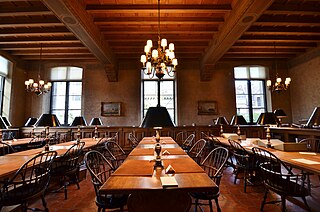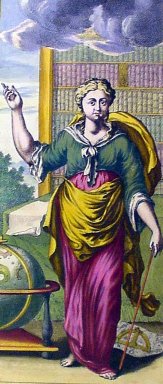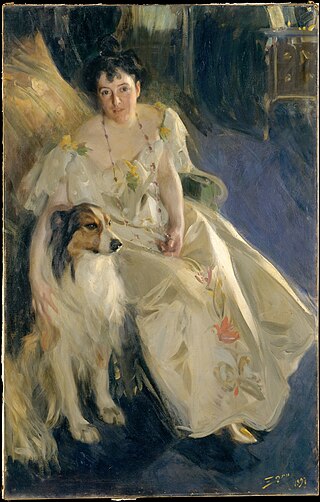Related Research Articles
Artstor is a nonprofit organization that builds and distributes the Digital Library, an online resource of more than 2.5 million images in the arts, architecture, humanities, and sciences, and Shared Shelf, a Web-based cataloging and image management software service that allows institutions to catalog, edit, store, and share local collections.
The California Digital Library (CDL) was founded by the University of California in 1997. Under the leadership of then UC President Richard C. Atkinson, the CDL's original mission was to forge a better system for scholarly information management and improved support for teaching and research. In collaboration with the ten University of California Libraries and other partners, CDL assembled one of the world's largest digital research libraries. CDL facilitates the licensing of online materials and develops shared services used throughout the UC system. Building on the foundations of the Melvyl Catalog, CDL has developed one of the largest online library catalogs in the country and works in partnership with the UC campuses to bring the treasures of California's libraries, museums, and cultural heritage organizations to the world. CDL continues to explore how services such as digital curation, scholarly publishing, archiving and preservation support research throughout the information lifecycle.

The Frick Art Research Library is the research arm of the Frick Collection. It is typically located at 10 East 71st Street on the Upper East Side of Manhattan in New York City. As of 2021, the library's reference services have temporarily relocated to 945 Madison Avenue.

Project MUSE, a non-profit collaboration between libraries and publishers, is an online database of peer-reviewed academic journals and electronic books. Project MUSE contains digital humanities and social science content from some 400 university presses and scholarly societies around the world. It is an aggregator of digital versions of academic journals, all of which are free of digital rights management (DRM). It operates as a third-party acquisition service like EBSCO, JSTOR, OverDrive, and ProQuest.

The Getty Research Institute (GRI), located at the Getty Center in Los Angeles, California, is "dedicated to furthering knowledge and advancing understanding of the visual arts".

The Soviet sale of Hermitage paintings in 1930 and 1931 resulted in the departure of some of the most valuable paintings from the collection of the State Hermitage Museum in Leningrad to Western museums. Several of the paintings had been in the Hermitage Collection since its creation by Empress Catherine the Great. About 250 paintings were sold, including masterpieces by Jan van Eyck, Titian, Rembrandt, Rubens, Raphael, and other important artists. Andrew Mellon donated the twenty-one paintings he purchased from the Hermitage to the United States government in 1937, which became the nucleus of the National Gallery of Art in Washington, D.C.
The Center for Research Libraries is a consortium of North American universities, colleges, and independent research libraries, based on a buy-in concept for membership of the consortia. The consortium acquires and preserves traditional and digital resources for research and teaching and makes them available to member institutions through interlibrary loan and electronic delivery. It also gathers and analyzes data pertaining to the preservation of physical and digital resources, and fosters the sharing of expertise, in order to assist member libraries in maintaining their collections.
Art historical photo archives are collections of reproductions of works of art that document paintings, drawings, prints, sculpture, architecture and sometimes installation photos. They are essential resource tools for the study of art history. Image collections deepen understanding of specific objects of art and the careers of individual artists as they also provide the means for a comparative approach to the study of artists’ works, national schools and period styles. The documentation that accompanies the images can also reveal patterns of art collecting, art market fluctuations and the changeable nature of public opinion. Photo archives build their collections and gather documentation for the works of art they record through purchases, gifts and photography campaigns. Information about ownership, condition, attribution, and subject identification is recorded at the time of acquisition and is frequently updated.

The Frick Art Research Library Photoarchive is a study collection of more than one million photographic reproductions of works of art from the fourth to the mid-twentieth century by over 40,000 artists trained in the Western tradition located in the Frick Art Research Library in New York. It was founded in 1920 by Helen Clay Frick, the daughter of industrialist Henry Clay Frick, to facilitate object-oriented research. The documentation it offers records the essential elements of the biography of the work of art: the artist, title, present owner, as well as historical information such as changes of attribution, ownership and condition, all of which are essential for the study of the history of art.

M. Knoedler & Co. was an art dealership in New York City founded in 1846. When it closed in 2011, amid lawsuits for fraud, it was one of the oldest commercial art galleries in the US, having been in operation for 165 years.

The Metropolitan New York Library Council (METRO) is a non-profit organization that specializes in providing research, programming, and organizational tools for libraries, archives, and museums in the New York metropolitan area. The council was founded in 1964 under the Education Law of the State of New York.

The Thomas J. Watson Library is the main research library of the Metropolitan Museum of Art, and supports the research activities of the museum staff, as well as outside researchers. It is located in the Met's main building, The Met Fifth Avenue.

The American Art Association was an art gallery and auction house with sales galleries, established in 1883.

The Brooklyn Museum Libraries and Archives holds approximately 300,000 volumes and over 3,000 linear feet of archives related to the history of the museum and its collections. The library collections comprise books, periodicals, auction catalogs, artist and institutional files as well as special collections containing photographs, sketches, artists' books, rare books and trade catalogues. The museum archives contains institutional records, curatorial correspondence, expedition reports, and other related textual and visual records dating to the founding of the institution.

Ethelwyn Manning was the second Chief Librarian of the Frick Art Reference Library. During World War II, she assisted the Committee of the American Council of Learned Societies (ACLS) on Protection of Cultural Treasures in War Areas, later known as the Monuments, Fine Arts, and Archives program (MFAA).

Virginia Purdy Bacon was an American heiress and art dealer.
Helen Sanger served as the fifth chief librarian of the Frick Art Reference Library and the institution's first Andrew W. Mellon Chief Librarian, a position inaugurated in 1990.
Patricia J. Barnett served as the sixth Chief Librarian and second Andrew W. Mellon Chief Librarian of the Frick Art Reference Library.

Valley of the Yosemite is a painting by the German American painter Albert Bierstadt that was completed in 1864. Initially associated with the Hudson River School, Bierstadt rose to prominence for his paintings of the Rocky Mountains, which established him as one of the best painters of the western American landscape. His later paintings of Yosemite were also received with critical acclaim and public praise.
Jean Herzberg Lipman was an American artist, collector, and art historian, a pioneer in the study of American folk art.
References
- ↑ Pogrebin, R (2010-03-14). "Groundbreaking Partnership Unites Decades of Research", The New York Times. Retrieved 2010-06-15.
- ↑ Lawrence, D (2009). "New York Art Resources Consortium: A Model for Collaboration", Art Documentation 28(2). Retrieved 2010-06-15.
- ↑ "Arcade, A New Shared Catalog, Positions Three Major New York City Art Museum Libraries for the Future of Art Research" (PDF). Retrieved 11 October 2011.
- ↑ "Frick Art Reference Library Photoarchive Records Now Online" (PDF). Retrieved 11 October 2011.
As of 15 June 2010, this article is derived in whole or in part from New York Art Resources Consortium. The copyright holder has licensed the content in a manner that permits reuse under CC BY-SA 3.0 and GFDL. All relevant terms must be followed.The original text was at "About Us"